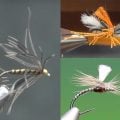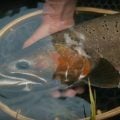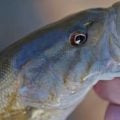“Blackfoot Autumn”

Upper Blackfoot Cliffs (Day 3)
I’m riding shotgun in a Toyota Four Runner outside Ovando, Montana, blazing across the sere yellow valley below layered green mountains, trying to figure out how to buy a Montana fishing license on my phone in a land where cell reception is like grizzly bears: for sure they’re around but it’s hard to say exactly where.
What with Covid, my travel game has gotten pretty rusty. I forgot almost as much stuff as I brought. Forgot my toothbrush. I remembered my electric razor, but forgot the charger. Realized I’d forgotten my antacids about one o’clock this morning after a few too many drinks with some convivial Texans. Ugh. Brought my four weight instead of my six. But I brought the right reel, over lined. Seven weight line on a four weight rod. Yeah, that’ll work.
Then there’s the small matter of my fishing license. The outfitter reminded me in I don’t know how many confirmation emails. There’s even a link on their website. I know enough to know that I need to buy a license before I leave for a trip. Or at the very least before I leave for the river on the first morning of fishing. But here I am, on my phone on the way to the river, trying to hold down last night’s dinner while doing my best to read the microscopic type on the Montana State Fish and Game website.
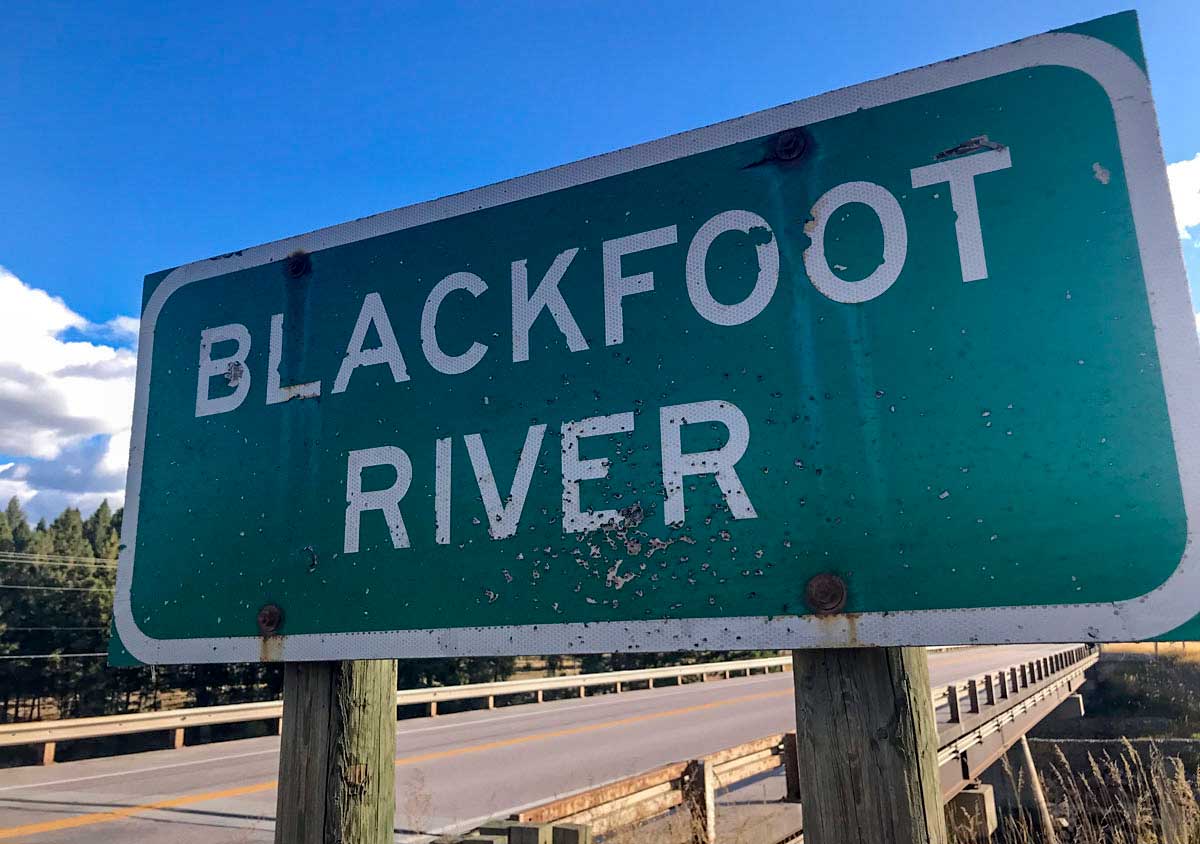
Best I can tell squinting at the bouncing screen, the state of Montana wants my “ALS” number. I’ve fished in Montana before, so guess I must have an ALS number. No idea what it might be though. So I try to bluff my way through. Not so fast city slicker – the web site pops up with a notification that in fact I do have an ALS number. But they’re not telling me what it is. That would be too easy. Instead they provide a handy link to another website where I can look it up.
So I go to the other website. Where they’ve never heard of me. Bureaucratic Catch-22 in a state that hates big government at fifty miles an hour on dirt roads towing a raft. Praying we don’t lose reception, it’s back to the main web site where I tweak the spelling of my name and the last digit of my social, put in my work address, pay my seventy six dollars and sixty five cents and just like that I’m a licensed Montana angler. Or a very close approximation of one.
Right on, let’s go fishing.
The North Fork of the Blackfoot joins the main river at our put in. There’s a few boats waiting to get on the river so Sawyer – who’s been driving all this time – and I put the rods together, wader up and mill around until it’s our turn. It’s a chilly, dark gray morning in late September.
Down at the river the wind’s blowing hard so I grab another layer out of my boat bag. I haven’t worn my wading boots for months and they’re killing my feet. I go down to the shore to get them wet so the leather will stretch. Stepping into the river for the first time I can’t help thinking: this is the water.

Blackfoot River Valley
If they’re able, all good Muslims go to Mecca during their lifetime. Rome is the place for Catholics; for Jews it’s the Western Wall. Just as every faithful Episcopalian must play the Old Course at St Andrews at least once before they die, every literary-minded fly fisher must eventually make their way to the Blackfoot River. My pilgrimage starts now.
Enough with the high-blown musings: it’s our turn. Hurry up and get the boat in and loaded because there are people waiting behind us. We finally launch and Sawyer rows us out into the current. It takes us down away from the confluence and suddenly all the rushing and jockeying, all the worries about the forgotten toiletries and licenses, evaporate and it’s just us, effortlessly floating the Blackfoot. Well, it’s effortless for me. Not so much for Sawyer on the oars.
This late in the season, most of the regular guides have left for jobs in hunting camps. Sawyer’s a fill-in and that’s fine with me. After four months on the water catering to the whims of the incompetent, over-confident and everything in between, a full-time guide can get pretty burned out. Sawyer’s young, eager to prove himself, happy to have the trip.
And when I say young, I do mean young. I’m used to fishing with guides who look like they might get carded at the liquor store. I’m pretty sure Sawyer gets carded at the movies. Turns out he’s a lot older than he looks — mid-twenties. Went to college in Gunnison to play football and, like many a Colorado kid, Gunnison ruined him for the better. He spent more time fishing than he did in class, lasted a year, and since then he’s lived the life we all sometimes wish we’d had the good sense to live, where everything takes a back seat to the central mission: being on the water with a fly-rod.
Brush and shrubs grow along the river bank, but beyond it’s flat flood-plain pasture. The wind blows up-river in our faces and down the neck of all three of my layers. The end of September feels like the middle of November. The good news about the bad weather is that while there are several boats at the put in, today we’ll see just two other boats. From what I understand, in July and August the Blackfoot can look like one of those rubber-ducky flotillas they do for charity.
I’m fishing Sawyer’s six weight. With nothing rising, a dry dropper rig with a beaded nymph is dish of the day. It’s typical fishing in a wide slow river, find seams and bubble lines and pools. Last night at dinner everyone moaned about how slow the fishing had been and today it’s more of the same. I’m catching a fish here and there on the dropper but it’s a lot of casting and not a lot of catching. That’s not criticism of Sawyer by the way – a guide’s job is to help his sport get the best out of what the day has to offer. There’s no question he’s doing that job well, this just isn’t the day.
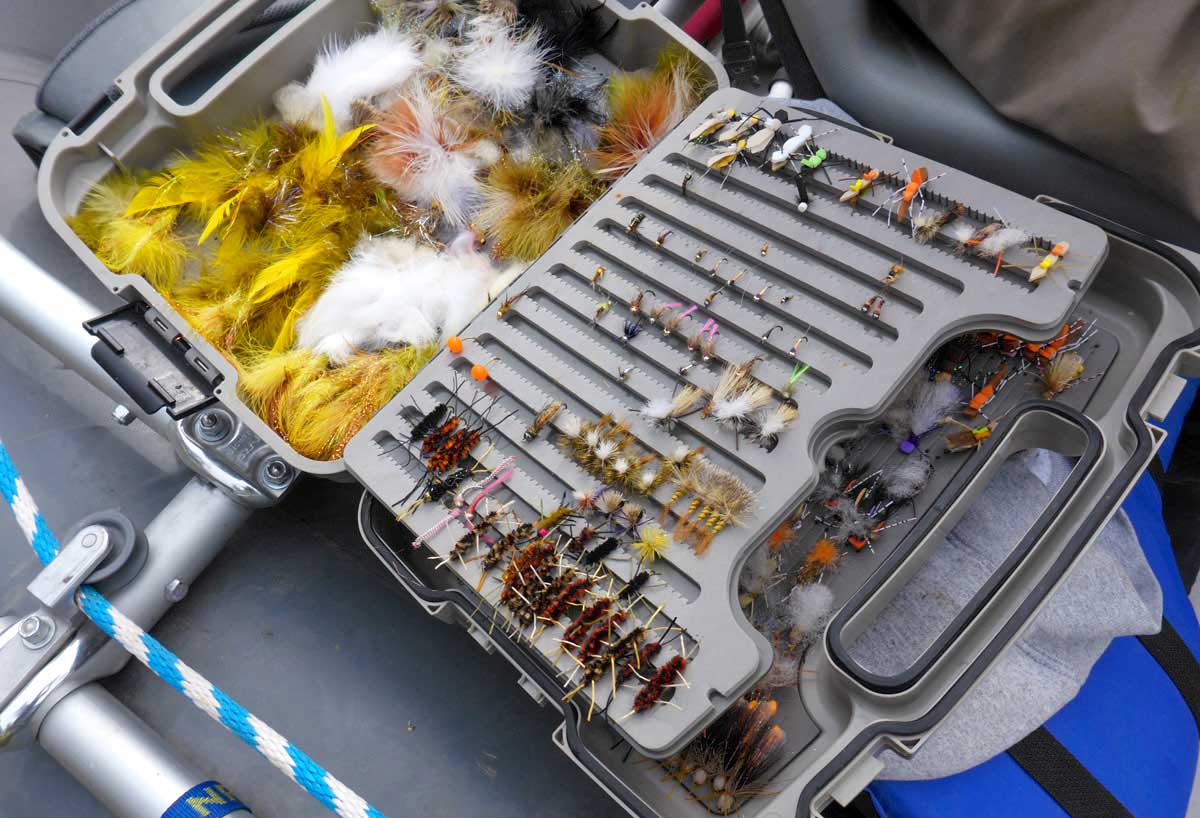
Sawyer’s Fly Box
As the morning passes, the river narrows and speeds up and the shore-line gradually rises until we’re passing through the canyon. A narrow slice of gray sky hangs above sheer purple cliffs, jagged thirty-foot shards lean off from the main cliff face. A filigree of deep green ponderosa pine, nervously blowing yellow aspens and brilliant red ossier dogwood bushes lines the river’s rocky edge. The most dramatic geology of all lies below in the achingly clear water: great boulders and deep pools and low sliding waterfalls over thrust-up slabs of living rock.
If Norman Maclean’s to be believed, there are words under those rocks. And I have to think some of those words are his. He describes this section of the river in close detail in A River Runs Through It. It’s early in the book when he and his brother Paul have decided to fish “the big river” before they have to take Norman’s bait-fishing brother-in-law across the divide on a picnic to Elkhorn Creek. Maclean writes, “The canyon above the old Clearwater bridge is where the Blackfoot roars loudest. The backbone of a mountain would not break, so the mountain compresses the already powerful river into sound and spray before letting it pass.” Maclean tells of catching a big fish on a dry and then walking downstream to watch his brother fish. Paul tucks his cigarettes under his hat, swims to a rock in the river to get a better angle for his cast, then “shadow casts” a dry fly over the water, keeping “the line circling over the water until fish imagined a hatch of flies was out.” He finally lays the fly softly on the water and soon after lands a big rainbow. “The canyon,” Maclean writes, “was glorified by rhythms and colors.”
It’s all pretty heady stuff – tucking your Luckies under your fedora, shadow casting dry flies with silk lines and bamboo rods. Back here on the present-day Blackfoot it’s a little more workman-like: baseball caps, Coke, and dry dropper rigs on plastic line and graphite rods. Still, if you care to listen, timeless continuities echo from these canyon walls.
Where the cliff faces and fallen boulders and layers of bed rock jut into the river they leave seams of bubbled water in their wake. I float the dry in the seams and from time to time a cooperative trout takes the dropper. I’m not exactly slaying them but land one here and there and though none are huge they’re solid and healthy – mostly cutthroats and the occasional white fish. You know the white fish before you see it: you’re sure your fly’s caught on a rock or log but no it’s just a white fish sulking on the bottom. Still, on a day of sporadic action, I’ll take what I can get. I mean holy hell – I’m fishing the Blackfoot canyon.
When we stop for lunch, I drink a Coke, eat my sandwich and suddenly – despite four layers – I’m shivering uncontrollably. My rod-tips quivers. The dry fly on the water trembles and a fish bumps it but, alas, doesn’t take it. Still I feel like a new fishing technique has been born – a way of working your fly that can only be achieved with border-line hypothermia.
Finally my stomach finishes dealing with my sandwich and some blood returns to my extremities. I stop shivering and can focus on fishing again. The afternoon passes pretty much like before, consistent but not spectacular action and some nice fish. And before I know it, we come around a bend and it’s the last little run of the day before the bridge take-out. Monture Creek flows into the Blackfoot just here and there’s a clear line of foam and flotsam where the currents meet. There’s also a couple of guys fishing with spin rods on the far shore. No choice but to go through the water they’re fishing. As we go past the confluence I lay my line on the water one last time today – and pull out a small cutty.
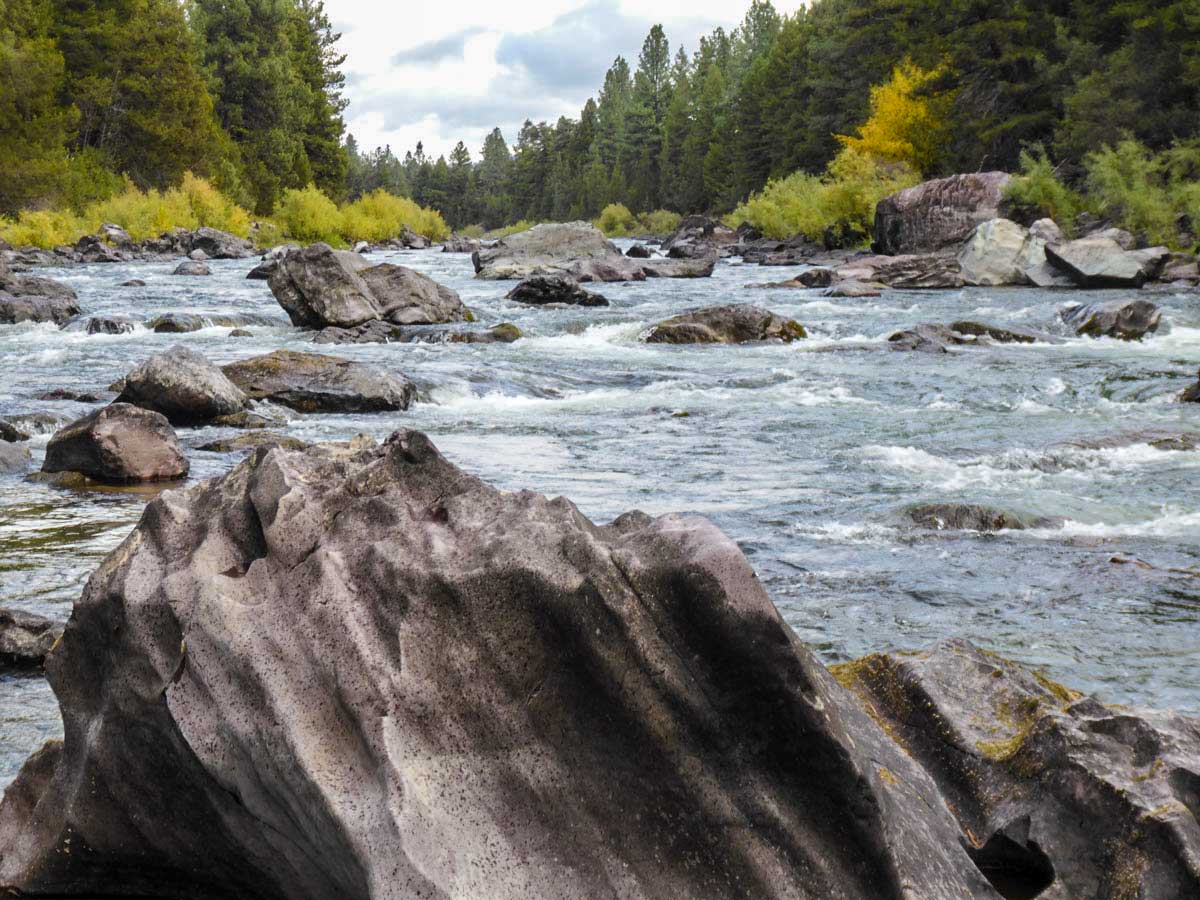
The Rock Garden
Sawyer says the guys with the spin gear probably aren’t too mad – they’re fishing (illegally) for bull trout. If a bull trout had come out and attacked my cutty and I landed him – which can happen – then they might have been peeved. But as it is I put the cutthroat back in the creek, it makes it through unscathed and the spin fisherman seem none the worse for us having poached their poacher’s water.
Next morning, I slide between pines down a steep, narrow rocky chute taking some gear to the river shore. I’m on all fours getting back up to the parking lot. Joel – who I’m fishing with today – backs the trailer to the top of the chute. We slide the raft off the trailer, pull it to the top of the precipice and give it a shove. It slides and bumps and bounces to the bottom. We follow and once Joel’s attached the anchor, we pull the raft out into the river, get it loaded and we’re on our way.
The section we’re fishing today is quite a ways below where I fished yesterday. It doesn’t take long to find out why Joel calls it the Rock Garden: the river’s littered with big jutting boulders all the way down and Joel’s constantly maneuvering the boat through this granite maze. It’s a little bit like a white water rafting trip with fishing as a bonus.
“The water’s low,” Joel says, “which is why I wanted to come here today. A lot of people can’t do this.” The way he says it doesn’t come off as bragging, it’s just flatly matter-of-fact: if you want to have water to yourself, fish where other people can’t fish.
Joel’s a school teacher in real life and since school’s started again he’s only guiding on weekends. He’s in his early fifties like me and I’m his last client of the season. And while Sawyer certainly proved the benefits of fishing with a young and eager guide, over the next couple days Joel will more than dispel the notion that the last client of the year will get a second-rate trip. Among other things, we won’t see a single other boat. It’s fair to say Joel works his ass off to make that happen.
In fact, he’s working his ass off right now. It’s super fun, fast-paced fishing as Joel threads us through long sections of boulders all the while telling me new places to fish in the pocket water and holes and seams as we shoot down river. Right, left, right, front, ten o-clock. It’s blowing my mind how he can navigate these boulder fields while at the same time guiding me and getting me into fish. We start catching fish almost immediately and as soon as one is off the hook we’re still blazing down river and before long another’s on. It’s like some sort of video game – constant forward motion and constant action casting, mending, picking up, new cast, mend, pick up, set hook. And on and on like that pretty much all day.
Not too far down, a series of cabins stare down from the high mud and root banks on both sides of the river. Joel says there’s supposed to be a regulation against houses being visible from the river. The idea being to preserve a sense of wildness when you float it. The cabins are part of a super-expensive resort. I saw the entrance from the highway when I was driving in from Missoula. It seems a combination of their money, influence and the fact that the cabins turn out to be technically “tents” allows them to skirt the rules. These tents, mind you, have running hot water and tiled bathrooms with toilets and showers. I’ve seen way worse on many a river, but still it’s a shame. Because there’s such a detailed and loving account of this river nearly a hundred years ago, the ability to experience continuities across the decades is one of the really special things about floating and fishing the Blackfoot.
In fact, much of the Blackfoot today probably resembles the river Maclean grew up with more than it did during the early nineteen-seventies, when he wrote his elegy for a lost time, a defiled river and the brother he could not save. At that point, a perfect storm of environmental abuse had devastated trout populations in the Blackfoot. The Mike Horse Mine at the headwaters had been leeching poison into the river for a hundred years. Irrigation diversion sucked trout into irrigation systems where they died. Pipes, culverts, clear-cut logging and channelization projects raised water temperatures and silted spawning beds. A century of abuse meant that the river Maclean had loved and fished in the twenties and thirties was, by the seventies and eighties, hardly even a shadow of its former self.
So how is it that we’re killing it today in the Rock Garden? Well, starting in the late seventies, a coalition of not-for-profits, businesses, government agencies, Indian tribes, outfitters and landowners got together to redeem the Blackfoot. It’s a long story, including massive mine clean ups, rerouting the river in certain places, upgrading road and irrigation infrastructure, improving livestock and logging practices. What’s amazing is that a lot of people with very different ways of looking at the world decided to focus on what they agreed on and put aside what they didn’t.
Some numbers go a long way in showing what mutual respect and pragmatic compromise can accomplish. In 1989 there were 0.46 pounds of west slope cutthroats per 1000 feet in the lower Blackfoot. By 2016, this number had increased to 10.8 pounds, more than 2,300 percent. In 1989, the canyon stretch I fished yesterday had 0.88 pounds of cutthroats per 1000 feet. By 2016, that was up to 26 pounds – an almost 3,000 percent increase. (Great Falls Tribune, 6/4/2017)
Which brings us back to the Rock Garden. We pull over to shore for a quick lunch and compare notes on how many fish we’ve caught. Joel and I have both lost count but it has to be around twenty. Mostly cutties around twelve inches, but a few bigger fish including a cutbow that went maybe sixteen. The dry we’re fishing is an October caddis pattern and while it’s gotten a few bumps almost everything has been on the dropper.
Finally, middle of the afternoon, a fish takes the dry out of a foamy seam along the shore. Actually that’s not fair to the river, the day or Joel: this afternoon there have been a few eats on the dry and a couple small landed fish, but I’ve been doing these spaz hooksets and several times I’ve yanked the dry right out of a fish’s mouth. So it’s more accurate to say that finally things come together with a nice fish taking the dry and me not ruining it.
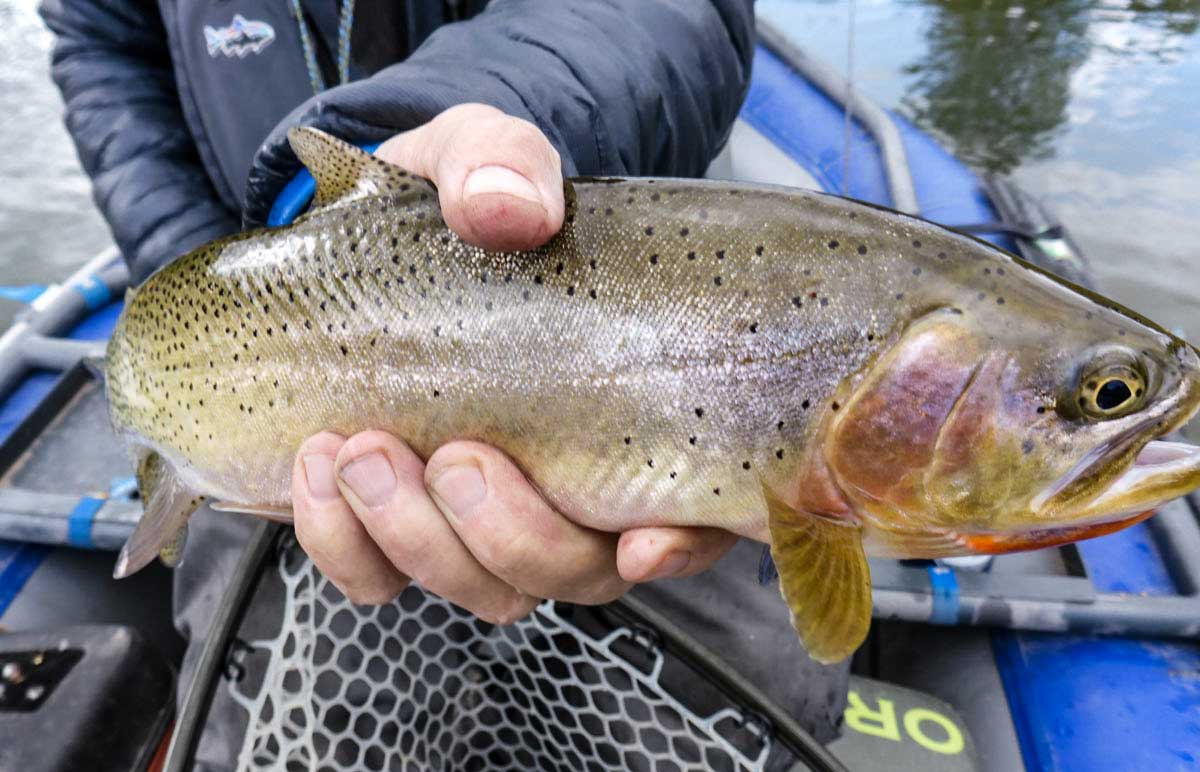
A healthy Blackfoot River cutthroat
After a respectable fight, we net a lean, athletic cutthroat, say fourteen inches, with deep dusky purple on the head and gills and the brilliant orange slit below its mouth. It’s amazing to think that in 1989 this fish would have represented the entire cutty biomass of a fifth of a mile of river. It’s amazing to think that this fish is just one of the latest in a line of west slope cutthroats that have made their living in this river since it was carved out in a geologic blink of an eye by the Missoula floods fourteen or fifteen thousand years ago. Talk about continuity.
It rained hard last night and this morning the higher peaks are white with the year’s first snow. We’re quite a ways upstream from where I fished the last two days and as we launch, the river’s wide and slow, almost like a spring creek. Shocks of autumn-gold grasses tumble over the shore, tips touching the water. Joel says during hopper season this section along the banks is killer. “I was hoping today we’d see some bugs coming off,” he says. But even though it’s a sunny and fairly warm morning, it was colder than expected last night and the rain cooled the river off even more.
So we’re fishing dry dropper again but without high hopes for the dry. Not a lot of action to start as Joel rows us through the slow still water, but we catch a few as we go along. The spring creek feel of the river slowly gives way to faster water and, on our right, high mud banks dotted with swallow holes. The mud banks rise into mud cliffs and then on down a ways the mud cliffs change to stone. It’s a lovely, subtle progression and as the shoreline rises and the sun rises the fishing starts to kick in.
Late morning we stop to pee and decide we might as well have lunch. That’s how your priorities are ordered when you get to be our age. As we’re pulling lunch out of the cooler, dark clouds roll over and the temperature drops ten or fifteen degrees. I put on my down jacket and then it’s raining hard and I think it will pass but it doesn’t and soon Joel and I are both hunkered down in our rain coats. We finish lunch in a little bit of a hurry — no point in lingering over lunch in the rain. Back at it. Before long the rain’s passed and not long after that the sun’s out again, the sky’s cloudless and blue and an easy but steady wind’s begun to blow.
I don’t know if it’s the wind or a bit of fatigue setting in, but I start tangling my leader every few casts. Most of the time it’s not bad and I can fix it myself. But there’s a few epic ones Joel has to take charge of. He’s not one to constantly correct your casting but he does say, after retying my leader, dry and dropper a few times, “You need to give it a little more time on the back cast.”
I’m always rushing the back cast. I think most of us do from time to time. We want to see our line again, we want to get the line where it’s going, we want to get the fly on the water. But when we rush, we don’t give the line the time it needs to do its job, which as much as anything is to load the rod so the rod can launch the fly out in front.
When I’m casting badly, I always find it’s best to go back to basics. Take your time. Give the rod and line time to do their jobs. Stiffen your wrist. Bring your elbow in to your side. In my mind, I return to the early pages of A River Runs Through It, where Maclean gives a perfect, economical description of the cast: “The one count takes the line, leader and fly off the water; the two count tosses them seemingly straight into the sky; the three count was my father’s way of saying that at the top the leader and fly have to be given a little beat of time to get behind the line as it is starting forward; the four count means put on the power …then check cast…”
It doesn’t get more basic than that – and that’s why it’s such a help when your cast has gone off the rails. A quick web search will find you any number of Maclean-inspired tattoos. A lot of white dude biceps are, apparently, haunted by waters. But my Maclean tattoo, if I got one, would begin, “The three count was my father’s way…” Maybe if I had this inked into my bleeding skin – or on the inside of my eyelids — I’d remember to pause on the back cast. I think Joel would tell you it’ll take more than that.
As the shadows lengthen in the late afternoon, our take-out comes into view. The afternoon, and the Blackfoot, have one last surprise in store for us. When a medium-sized cutthroat takes the dry I set the hook well – not too hard, not too slow. But the fight feels odd, like I’ve foul-hooked the fish. I bring the fish to the side of the boat and Joel plunges down with his net. When he brings it out of the water, there are two cutthroats in it. Neither has a fly in its mouth or in its body, although they’re both a bit tangled in the leader. Luckily Joel has had plenty of practice today cutting leaders. He snips them free and lowers the net back into the water. The trout right themselves, seem to glance at each other in disbelief at what actually just went down, and then dart back into the river. As a certain long-dead Presbyterian minister was fond of saying: Beautiful.








